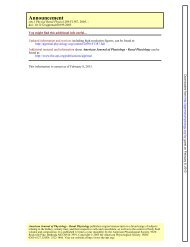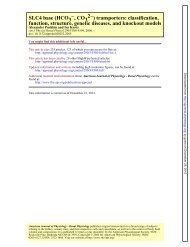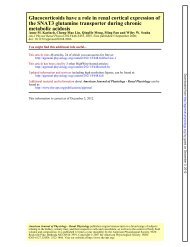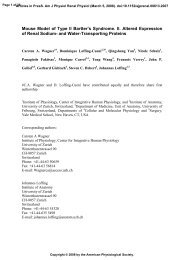Increased susceptibility of aging kidney to ... - Renal Physiology
Increased susceptibility of aging kidney to ... - Renal Physiology
Increased susceptibility of aging kidney to ... - Renal Physiology
You also want an ePaper? Increase the reach of your titles
YUMPU automatically turns print PDFs into web optimized ePapers that Google loves.
F1278 AGING KIDNEY AND ISCHEMIC INJURY<br />
before a coverslip was mounted <strong>to</strong> the slides. Negative controls were<br />
incubated with TBS in place <strong>of</strong> the primary antibody.<br />
Urinary Kim-1 quantiation. Urine samples were coded so that<br />
individuals performing the analyses were blinded as <strong>to</strong> the identity<br />
<strong>of</strong> the samples. Kim-1 protein was measured using Microspherebased<br />
Luminex xMAP technology with monoclonal antibodies<br />
(MARKE-Trap and MARKE) raised against rat Kim-1 in the<br />
Vaidya/Bonventre Labora<strong>to</strong>ry. This assay has been used <strong>to</strong> determine<br />
urinary levels <strong>of</strong> Kim-1 in several recent studies in rats (8, 27,<br />
43, 44). For measurements, 30 �l <strong>of</strong> urine samples were analyzed<br />
in duplicate.<br />
Statistics. For all statistics except microarray analysis, an ANOVA<br />
followed by post hoc t-tests with the Bonferoni correction was used <strong>to</strong><br />
assess statistical significance (P � 0.05) via the SPSS program.<br />
RESULTS<br />
Age-related <strong>susceptibility</strong> <strong>to</strong> injury. Initial studies were designed<br />
<strong>to</strong> test the hypothesis that <strong>aging</strong> was associated with an<br />
increased <strong>susceptibility</strong> <strong>to</strong> injury. An in vitro system that<br />
preserves organ architecture and heterogeneity was used <strong>to</strong><br />
eliminate the variables <strong>of</strong> renal blood flow and inflammation,<br />
which are also affected by <strong>aging</strong> (6, 11, 16). Precision-cut<br />
<strong>kidney</strong> slices generated from young, aged-AL, and aged-CR<br />
rats were challenged by a simulated ischemic insult (100% N2).<br />
Slice viability was measured at 30 and 60 min using a number<br />
<strong>of</strong> parameters including intracellular ATP and GSH levels and<br />
leakage <strong>of</strong> LDH and �GST (a marker <strong>of</strong> proximal tubular<br />
Fig. 5. Impact <strong>of</strong> <strong>aging</strong> on Kim-1 expression. A: quantiative PCR analysis <strong>of</strong> Kim-1 gene expression; the �-actin normalized Kim-1 gene expression is presented<br />
relative <strong>to</strong> the gene expression in an arbitrary reference sample (Stratagene Rat Universal Reference RNA). The values represent means � SD <strong>of</strong> relative gene<br />
expression <strong>of</strong> 4 animals per group. *Significant difference in 24-mo AL compared with young. **Significant difference in aged-AL compared with young and<br />
aged-CR. B: Western blot analysis <strong>of</strong> Kim-1 protein levels in <strong>kidney</strong> lysates. Full-length Kim-1 is seen at �80 kDa, while fragments at 30 and 45 kDa are also<br />
seen; the bands at 50 kDa are nonspecific but demonstrate equal protein loading. C: paraffin-embedded sections were processed for immunohis<strong>to</strong>chemical<br />
localization <strong>of</strong> Kim-1 with a commercially available system (Zymed); similar results were seen in duplicate experiments. D: Kim-1 levels in rat urine as assessed<br />
by ELISA. Each data point represents means � SD <strong>of</strong> 4 animals per group. **Significant difference in 24-mo AL compared with young and 24-mo CR.<br />
AJP-<strong>Renal</strong> Physiol • VOL 293 • OCTOBER 2007 • www.ajprenal.org<br />
Downloaded from<br />
http://ajprenal.physiology.org/<br />
by guest on December 6, 2012








